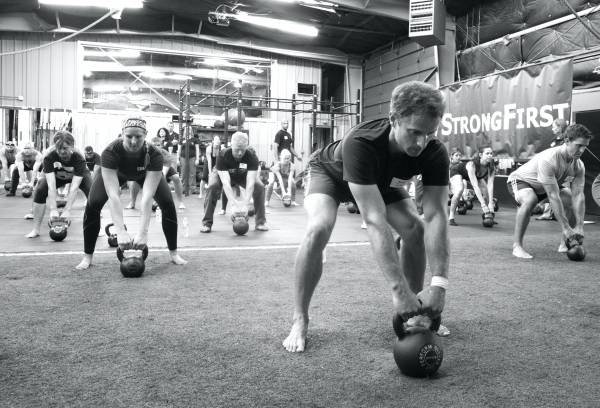When I ask female athletes about their goals, improving their glutes is at the top of the list. In this article, I will discuss how well the standard squat develops the glutes, along with squat variations and exercises that work better.
The hip thruster is an obvious glute developer, but some people find it embarrassing to thrust your hips into a barbell in a public setting. So I’ll make the exercises male-friendly as well, and I promise there will be no awkward hip thrusters.
Combatting Quad Domination
“She Squats” is a popular meme, often accompanied by pictures of women with highly structured glutes. It might be true that she squats, but often the squat does not activate the glutes as much as it could. Many men and women learn to be quad-dominant in the squat, as well as in running and jumping. This means they forego using their glutes because of poorly developed movement patterns.
The squat is a complicated movement that activates many different muscles. Front squats and back squats activate the thighs and the glutes in a different way. In general, the more upright the torso, the more the thighs will activate and the less the glutes are needed. For example, some people use the spinal erectors to pull their back upright and finish the movement with the thigh muscles.
“Kneeling squats, banded kneeling squats, and kettlebell swings are great ways to activate the glutes without awkward hip thrusting movements in a public setting.”
Looking closer, we can see similar patterns in running and jumping. Some people run almost as if they are pulling their bodies forward. Hip flexors drag the legs and the thighs absorb the force of landing. Compare that to someone who uses her glutes and hamstrings to propel forward. She pushes off the ground and launches herself forward. (See Andrew Read’s excellent book, Run Strong, for much more detailed explanations on running patterns.)
Test Your Glutes
With a partner, lay down flat on your stomach. Lift your heel toward your backside and raise your leg off the ground. Have your partner press your hamstring toward the ground. If you can resist your partner pressing down, then you can activate your glutes well. If your partner can press your leg back down, you might have a problem activating your glutes. This has been called gluteal amnesia. In other words, you’ve forgotten how to use your glutes.
How to Activate Your Glutes
The hip thruster is one of the most effective movements in activating the glutes. Bret Contreras found more gluteal activation when people did hip thrusters versus squats. For those of you who might be self-conscious doing hip thrusters, let’s try to covertly activate the same muscles.
Kneeling Squats
The kneeling squat seems complicated and dangerous until you try it. It actually simplifies the squat by limiting it to a one-joint movement (the hip hinge). To do kneeling squats, kneel on the floor with a bar on your back. Use a cushion under your knees if you experience discomfort. Sit back until your backside touches your calves, then sit back up. You should feel glute activation in this movement.
Banded Kneeling Squats
This movement is secretly a hip thruster, but it’s a little less awkward. The setup is the same as kneeling squats, except you place a band around your hips so the tension pulls you backward. Sit back on your lower legs and thrust forward. You will feel more tension at the end of the movement as the band is stretched the most.
Kettlebell Swings
The kettlebell swing is one of the best covert hip thrust movements we can do. This explosive movement focuses the observer’s eyes on the kettlebell, but when we break down the movement, we can see hip thrusts right before our eyes. This exercise is a great glute developer and could be the reason behind the moniker “kettlebooty”.
The key to doing a swing properly is to hinge the hips back. A swing is not a squat. One cue is to think of your calves being stuck in concrete in a vertical position. Your knees bend as your backside shoots back. Your lower leg should stay vertical to the ground. The more explosive your hips are in firing the kettlebell upward, the more glute activation you will feel.
The Role of The Hip Hinge
Individual differences play a major role in how much squats activate the glutes. In a squat, our ankles, knees, and hips all work together. With so many different joint angle possibilities, everybody will activate muscles differently.

Limiting the movement to the hip hinge allows for better glute activation. Kneeling squats, banded kneeling squats, and kettlebell swings are great ways to activate the glutes without awkward hip thrusting movements in a public setting. These movements will even give you more glute involvement in your full squat.
More on gluteal development:
More on gluteal development:
- 4 Simple Exercises to Get Your Glutes Fired Up
- The 2-Minute Workout for Strong and Powerful Glutes
- The Butt of a Backbend: A Lesson in Gluteal Anatomy
- New on Breaking Muscle Today
References:
1. Bret Contreras, Andrew D. Bigotsky, Brad J. Schoenfeld, Chris Beardsley, and John Cronin. “A Comparison of Gluteus Maximus, Biceps Femoris, and Vastus Lateralis EMG Activity in the Back Squat and Barbell Hip Thrust Exercises.” Journal of Applied Biomechanics, 2015. doi:10.1123/jab.2014-0301.
Photo 1 courtesy of Rx’d Photography.
Photo 2 courtesy of StrongFirst.
a






